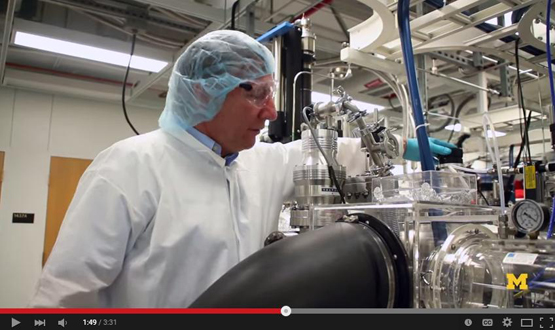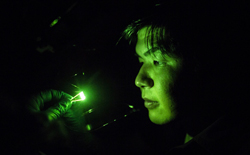Stephen Forrest named Peter A. Franken Distinguished University Professor
Prof. Forrest is internationally-renowned and easily one of the most prolific inventors in academia today.

 Enlarge
Enlarge
Stephen Forrest has been named the Peter A. Franken Distinguished University Professor of Engineering in acknowledgement of his extraordinary accomplishments that have brought distinction to himself, his students, and to the entire University.
The Distinguished University Professorship, established in 1947, recognizes professors for exceptional scholarly or creative achievement, national and international reputation, and superior teaching skills. Faculty are given the opportunity to determine the name of the professorship. By taking the name of Peter A. Franken for his professorship, Prof. Forrest honors Dr. Franken’s legacy as the “father of nonlinear optics,” as well as the rich history of optics at Michigan.
Prof. Forrest has several points of association with Peter A. Franken, whose groundbreaking work in nonlinear optics while at Michigan helped launch what has been called a golden age in optical physics. “Peter was a friend of my thesis advisor, Mike Sanders,” said Prof. Forrest. “One other point of contact is that Prof. Franken’s student, Mike Bass (PhD Physics ’64), offered me my first academic appointment when he was Chair of Electrophysics at USC. Finally, my own work is in optics, including optics of materials and nonlinear optics.”
Prof. Forrest is an internationally-renowned researcher, educator, and entrepreneur – and easily one of the most prolific inventors in academia today. As director of the Optoelectronic Components and Materials (OCM) Laboratory, he and his group conduct research on photovoltaic cells, organic light emitting diodes, and lasers & optics. His investigations in these areas span decades, and have resulted in five startup companies, 277 issued patents, and key technologies that are pervasive in the marketplace. In addition, he has graduated 54 Ph.D. students.
One of his early successes as an inventor dates back to his work at Bell Laboratories, his first job upon receiving his doctoral degree from Michigan. There he solved a crucial issue with photodetectors in long distance fiber optic networks. His solution resulted in a planar p-i-n indium gallium arsenide long wavelength detector that is now used in virtually every long distance fiber optic system in the world. He later invented an even more sensitive detector, the long wavelength avalanche photodiode, that is also in production around the world.
In the late 1990’s, Prof. Forrest and his collaborators (Prof. Mark Thompson at USC and graduate student Marc Baldo, now a professor at MIT) introduced the concept of electrophosphorescence, which catapulted organic light-emitting diode (OLED) technology from a technological curiosity to being the most energy-efficient light emitting source known. The OLED industry now represents a $14B global market, and his group’s phosphorescent OLED technology is used widely in cell phones and TVs.
Prof. Forrest’s research group has also solved numerous basic problems related to the development of organic solar cells. The cells produced in Prof. Forrest’s laboratory regularly achieve world-record performance for both operational lifetime and efficiency, and are currently the basis of yet another of his companies, NanoFlex Power Corporation.
Related to his fundamental investigation in organic solar cells, Prof. Forrest developed an ideal diode equation for organic junctions. This equation provided a formalized framework for understanding organics for the first time. This achievement has been likened to William Shockley’s ideal diode equation for semiconductor junctions – an equation that served as the foundation of modern electronics.
Yet another important area of innovation achieved by Prof. Forrest and his group is the development of three new methods for growing organic thin films. These methods have either been widely adopted by the academic community or have been commercialized. One of these methods may enable the printing of organic circuits from a desktop computer.
Throughout his remarkable career, Prof. Forrest has maintained strong ties with industry, and participated in the founding of five companies: Epitaxx (purchased by JDSU), Sensors Unlimited (purchased by Goodrich), Universal Display Corp. (traded as OLED on NASDAQ), Global Photonic Energy Corp. (now NanoFlex Power Corp.) and ASIP Inc. (now part of Avago Technologies). Sensors Unlimited sold for approx. $650M, and Universal Display Corp. has a current market capitalization of over $2.5B.
Prof. Forrest is also a gifted educator, administrator, and leader. Of his 54 Ph.D. graduates and 28 postdoctoral researchers, 18 are professors and deans at major universities; several are industry leaders; and others are successful entrepreneurs. He is currently writing a textbook on organic electronics.
As U-M’s Vice President for Research (a position held from 2006 to 2013), he initiated several key processes that have helped make Michigan one of the leading institutions in the country in the area of tech transfer. For example, he instituted the Business Engagement Center which doubled U-M industry research volume in only 6 years. Under his reign, Michigan’s research funding grew from $823M to $1.33B.

 Enlarge
Enlarge
Prof. Forrest received his B.A. in physics in 1972 from the University of California, Berkeley, and his M.S. and Ph.D. degrees in physics from the University of Michigan in 1974 and 1979, respectively. He joined AT&T Bell Laboratories in 1979, and left in 1985 to join the faculty at University of Southern California, where he served as Director of the National Center for Integrated Photonic Technology, a five-university research consortium funded by DARPA. In 1992, he joined Princeton as the James S. McDonnell Distinguished University Professor of Electrical Engineering. He was director of the Center for Photonics and Optoelectronic Materials (POEM), and served as the Chair of the Electrical Engineering Department from 1997-2001. In 2006, Prof. Forrest returned to University of Michigan as Vice President for Research and the William Gould Dow Professor in Electrical Engineering. He was named the Paul G. Goebel Professor of Engineering in 2014, and holds appointments in Electrical Engineering and Computer Science, Physics, and Materials Science and Engineering.
Prof. Forrest has authored approximately 550 papers in refereed journals and given more than 670 talks. He has served on dozens of professional and industrial boards and committees, including his current board membership with Applied Materials and PD-LD, Inc., Technion Board of Governors, Universal Display Corp, NanoFlex Power Corp., the University Musical Society (chairman of the board) and Ann Arbor SPARK (founding member).
Throughout his career, Prof. Forrest has received numerous honors. He received the IEEE/LEOS Distinguished Lecturer Award from 1996 to1997 and in 1998, he was a co-recipient of the IPO National Distinguished Inventor Award as well as the Thomas Alva Edison Award for innovations in organic LEDs. In 1999, he received the MRS Medal for work on organic thin films, and in 2001, he was awarded the IEEE/LEOS William Streifer Scientific Achievement Award for advances made on photodetectors for optical communications systems. In 2006, he received the Jan Rajchman Prize from the Society for Information Display for the invention of phosphorescent OLEDs, and in 2007, he was a recipient of the IEEE Daniel Nobel Award for innovations in OLEDs. In 2015, Prof. Forrest was named a fellow of the National Academy of Inventors, and was named the 2015 U-M Distinguished University Innovator. He is a Fellow of the APS, IEEE, OSA, and a member of the National Academy of Engineering.
Prof. Forrest will present a special lecture in Fall 2015 in honor of being named the Peter A. Franken Distinguished University Professor.

 Enlarge
Enlarge
Peter A. Franken (1928-1999) is widely considered the father of nonlinear optics. In 1961, Dr. Franken and colleagues at the U-M Harrison M. Randall Laboratory of Physics were the first to observe the generation of optical harmonics when they focused a ruby maser (precursor to the modern laser) onto a quartz crystal. They generated ultraviolet radiation from red by doubling the frequency of laser light, an effect that could not be explained by conventional electromagnetic theory.
This foundational research led to experimental and theoretical research in nonlinear optics that continues to this day at Michigan and around the world. Nonlinear optics has led to important applications in optical communications, biological imaging, X-ray generation, laser surgery, and homeland security.
Dr. Franken received his B.S., M.S., and Ph.D. degrees in Physics from Columbia University in 1948, 1950, and 1952, respectively. He taught at Stanford University after graduation, and then joined the University of Michigan in 1956. He served as deputy directory and acting director of the Advanced Research Projects Agency (ARPA) between 1966-1968, and left Michigan in 1973 to join the University of Arizona as director of its Optical Sciences Center. Dr. Franken was named president of the Optical Society of America in 1977, received the OSA Wood Prize in 1979, and was elected as a foreign member of the Russian Academy of Engineering Sciences in 1997.
More Info
Generation of Optical Harmonics, by Peter Franken, A. E. Hill, C. Wilbur Peters, and Gabriel Weinreich, Physical Review Letters, August 15, 1961. Landmarks – Ruby Red Laser Light Becomes Ultraviolet, Physics 7, October 31, 2014. A review of the landmark paper, Generation of Optical Harmonics, by Peter A. Franken. Oral History Transcript, Dr. Peter Franken. Peter Franken(1928-1999), Michigan Physics. Obituary, Physics Today, October 1999.
More News about Stephen Forrest
Recent Accomplishments
Named 2015 Dist. University Innovator

 Enlarge
Enlarge

 Enlarge
Enlarge
Low-cost Thin-film Flexible Optoelectronics (OCM Group Research Projects)

 Enlarge
Enlarge

 Enlarge
Enlarge
Photon Glue Enables New Quantum State That Could Mean Better Lighting, Solar Cells

 MENU
MENU 
